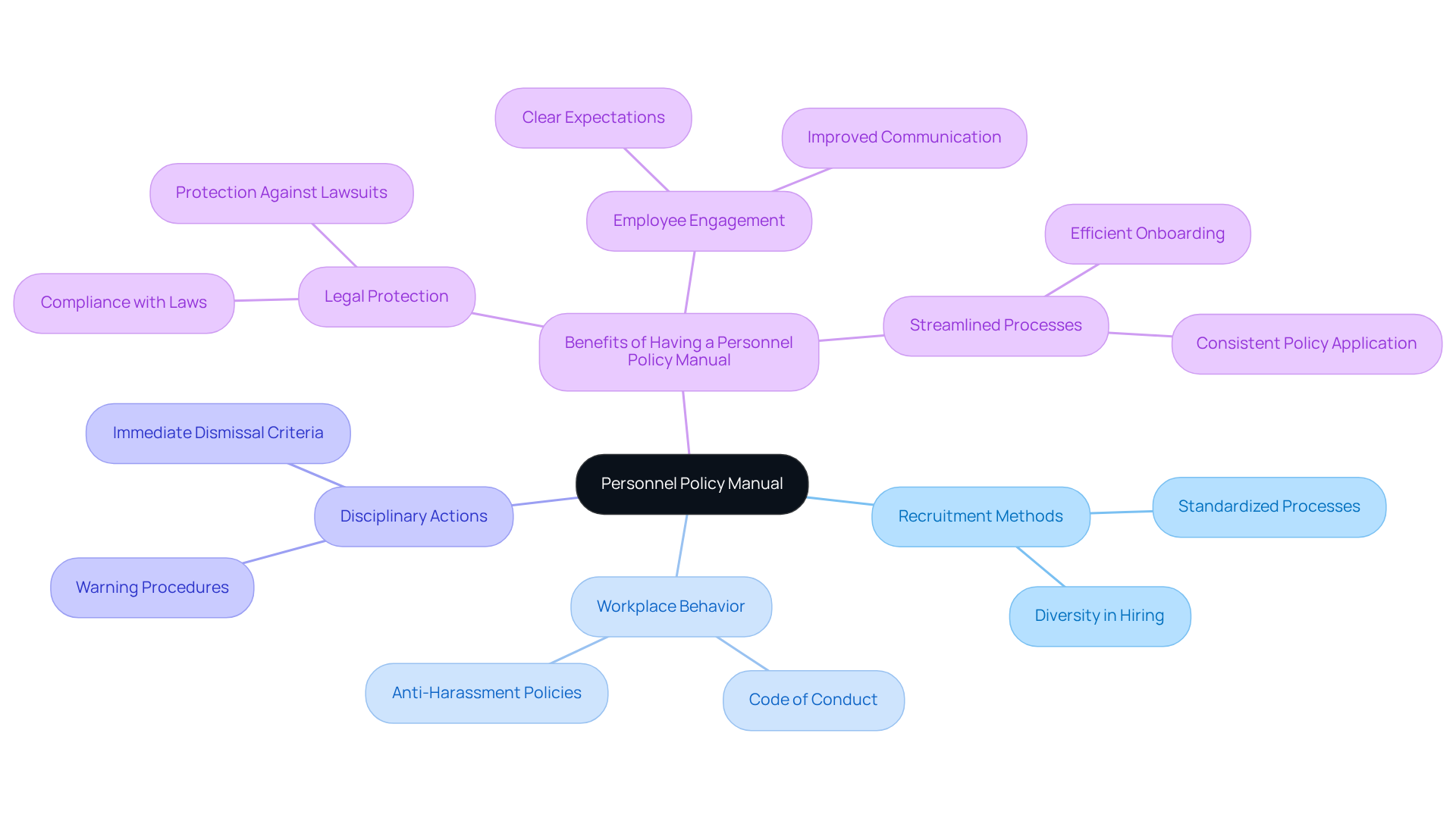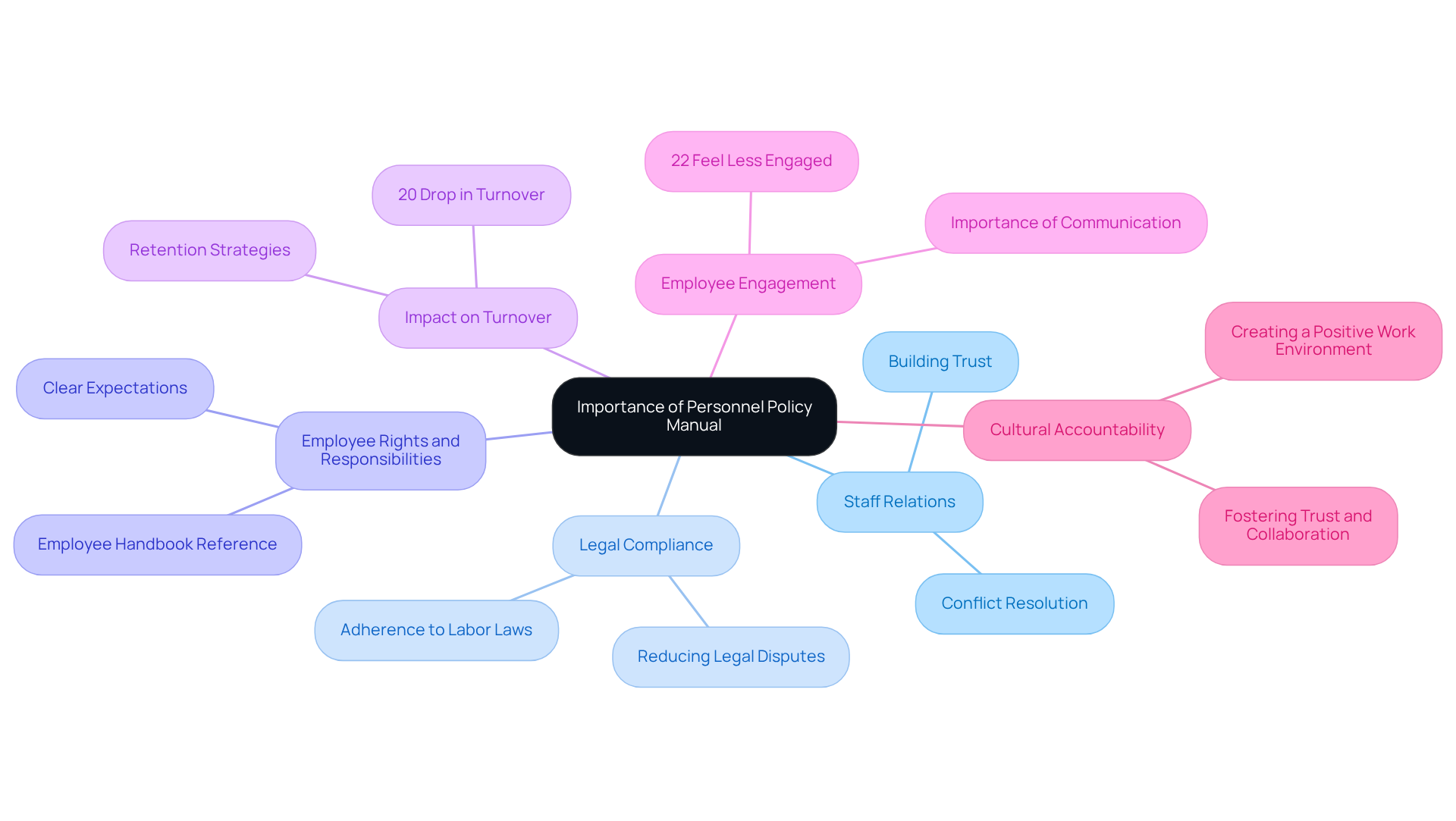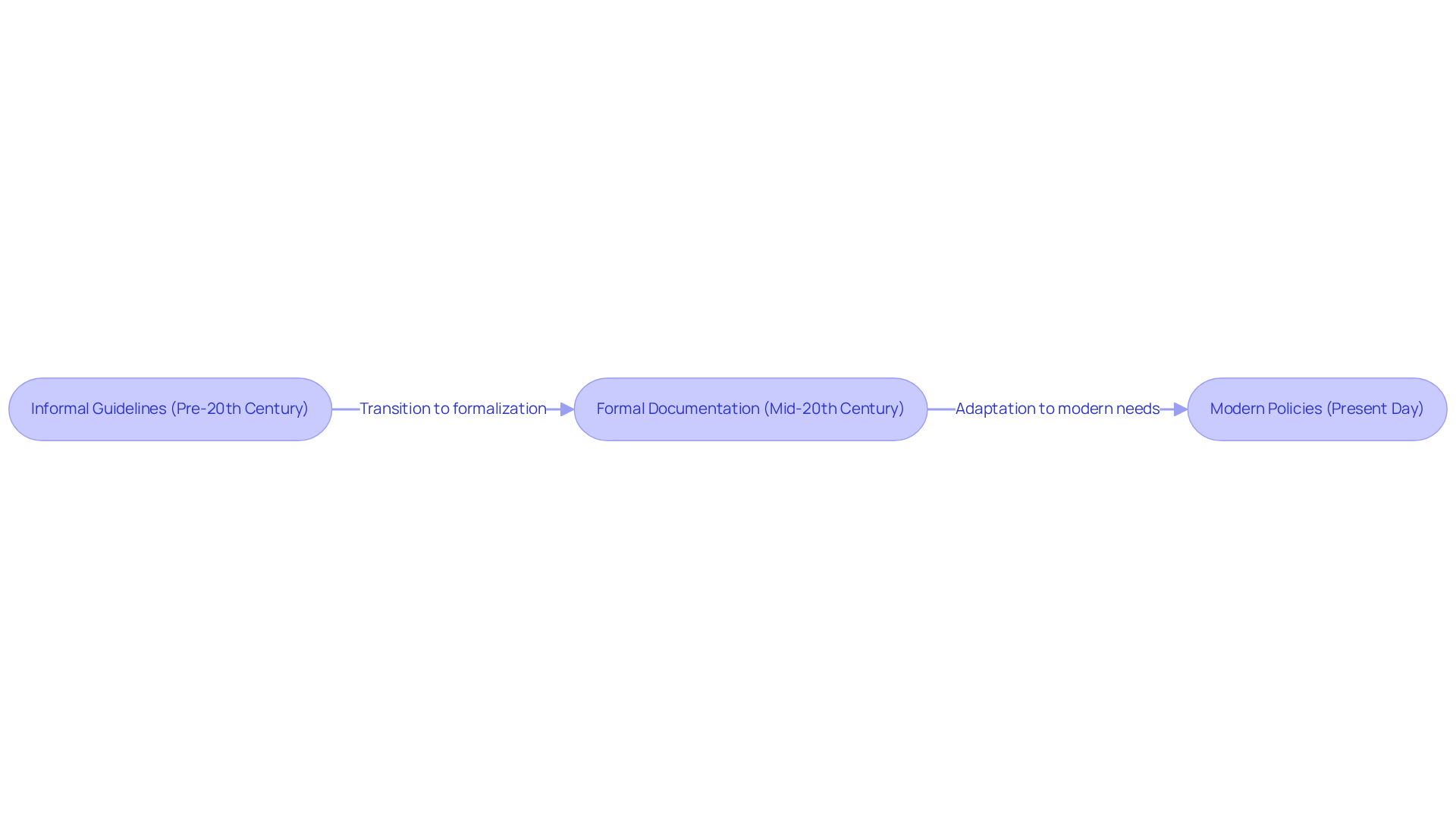
Remote Team Documentation Strategies
|
November 12, 2025
|
Understanding the Personnel Policy Manual: Importance and Key Components
Key Highlights:
- A personnel policy manual outlines rules, procedures, and expectations for employment relationships in organisations.
- It covers topics such as recruitment methods, workplace behaviour, and disciplinary actions, promoting a fair work environment.
- Having a solid manual helps protect organisations from legal issues, enhances employee engagement, and clarifies expectations.
- Organisations with clear guidelines can reduce turnover by 20% and boost employee engagement by minimising conflicts.
- The evolution of personnel manuals reflects changes in labour laws and modern workplace trends, emphasising the need for ongoing updates.
- Key components of a personnel policy manual include introduction, employment policies, compensation and benefits, workplace conduct, health and safety, leave policies, and grievance procedures.
- Effective documentation practises are essential for organisational success and should be integrated into company culture.
Introduction
You might be wondering, what’s the deal with a personnel policy manual? Well, think of it as the backbone of your organization. It lays out the rules and expectations that guide how employees behave and how management operates. By setting clear guidelines, this essential document not only creates a fair and transparent workplace but also helps protect organizations from potential legal issues.
But here’s the kicker: how can businesses keep their manuals up-to-date with all the changing labor laws and workplace dynamics? Let’s dive into why a personnel policy manual is so important and what key components it should include. You’ll see that it’s not just a necessity; it can truly transform employee engagement and boost organizational success.
Define Personnel Policy Manual
You might be wondering what a staff guidelines document really is. Well, it’s basically a formal record that lays out the rules, procedures, and expectations that shape the employment relationship in any organization. This handy personnel policy manual serves as a win-win for both staff and management, addressing important topics like:
- Recruitment methods
- Workplace behavior
- Disciplinary actions
By standardizing how these guidelines are understood and applied, it helps create a fair and transparent work environment.
Now, here’s something to think about: organizations that have a solid personnel policy manual are in a much better position to protect themselves from legal issues, like wrongful termination or discrimination. Plus, they often see a boost in employee engagement and satisfaction. Imagine having a well-crafted guide that not only improves communication but also clarifies expectations—this can lead to a more unified organizational culture.
Speaking of that, with SowFlow, creating and updating your personnel policy manual is a breeze! You can make quick updates to keep your practices relevant and aligned with any changes in the organization. This not only helps streamline processes but also makes onboarding and knowledge sharing smoother, ultimately ramping up team efficiency. So, why not take a closer look at how effective documentation can transform your workplace?

Explain Importance for Businesses
You might be wondering why a personnel policy manual is so important for organizations. Well, it’s all about creating a solid framework that helps manage staff relations and sets clear expectations. By keeping things in line with labor laws and regulations, these guides can really help reduce the chances of legal disputes. Plus, they serve as a handy reference for employees, outlining their rights and responsibilities, which can lead to happier and more productive teams.
For instance, did you know that companies with clear guidelines see a 20% drop in turnover within the first 45 days of employment? That really highlights how crucial transparent communication is right from the start! And let’s not forget that 22% of employees feel less engaged at work due to conflicts. This just goes to show how important it is to have a personnel policy manual in place to boost staff relations.
By laying down transparent guidelines, organizations can build a culture of accountability, which in turn fosters trust and collaboration among team members. As Doug Conant wisely said, "To win in the marketplace you must first win in the workplace." This really underscores the link between employee engagement and business success. So, not only do these structured approaches improve employee relations, but they also create a more harmonious and productive workplace, ultimately driving the organization toward success.
Now, let’s dive into how you can implement these ideas in your own workplace!

Trace Historical Development
Have you ever considered how much the personnel policy manual has changed over the years? It’s pretty fascinating! Initially, these guidelines were often informal and shared verbally, which led to a lot of confusion and inconsistency. But as companies grew and labor laws tightened up, the need for formal documentation became clear. By the mid-20th century, many businesses recognized that having a solid personnel policy manual was crucial for standardizing practices and keeping up with evolving legal standards. This shift not only brought clarity but also protected both employees and employers from potential disputes.
Fast forward to today, and the personnel policy manual is still evolving. They now include modern workplace trends like remote work protocols, flexible schedules, and diversity and inclusion initiatives. These updates show just how dynamic our workforce is and highlight the importance of creating inclusive and supportive work environments. For instance, did you know that a mistake made by a worker at IBM cost the company $600,000? That really drives home the point about the financial impact of not having strong regulations and the need for solid documentation practices.
At SowFlow, we believe that documentation shouldn’t be a one-time task. Instead, it should be a systematic approach that becomes part of the company culture. This mindset ensures that the personnel policy manual is not only created but also regularly updated and maintained. This way, organizations can quickly adapt to changes in workplace dynamics and legal requirements. As companies strive to build a culture of engagement and accountability, the role of personnel handbooks has become increasingly vital in guiding employee behavior and aligning with organizational goals.
Steve Wynn once said, 'Human Resources isn't a thing we do. It's the element that drives our business.' This really emphasizes how crucial effective personnel practices are for organizational success. So, what do you think? Are your documentation practices up to par?

Identify Key Components and Characteristics
A well-structured personnel policy manual typically includes several key components that are essential for effective organizational management. You might be wondering what those components are, so let’s break it down:
- Introduction: This part sets the stage by explaining the manual's purpose and sharing the organization's mission and values. It’s all about establishing the tone for the guidelines that follow.
- Employment Policies: Here, you’ll find details on hiring practices, equal opportunity employment, and anti-discrimination policies. This ensures that the organization complies with legal standards while fostering an inclusive workplace.
- Compensation and Benefits: This section dives into salary structures, benefits packages, and payroll practices. These elements are crucial for attracting and keeping top talent.
- Workplace Conduct: What are the expectations for staff behavior? This section lays out codes of conduct and disciplinary procedures, promoting a respectful and productive work environment.
- Health and Safety: A vital piece of the puzzle, this part covers safety protocols and staff responsibilities regarding workplace safety. It reflects the growing focus on worker well-being and adherence to new labor regulations.
- Leave Policies: This section outlines vacation, sick leave, and other forms of leave available to staff. It’s all about ensuring clarity and fairness in time-off practices.
- Grievance Procedures: Offering a framework for staff to voice concerns and seek resolutions, this section is key for maintaining open communication and trust within the organization.
By incorporating these components, organizations can create a comprehensive personnel policy manual that acts as a valuable resource for both employees and management. Now, speaking of creating these policies, have you heard about SowFlow's instant documentation solution? It makes crafting and updating these policies a breeze! With SowFlow, teams get immediate access to essential information, boosting operational efficiency and supporting effective onboarding and knowledge sharing. This way, your manual stays relevant in an ever-changing business landscape.

Conclusion
You might be wondering why a personnel policy manual is such a big deal for any organization. Well, think of it as your go-to guide that lays out the rules, procedures, and expectations for everyone involved. It’s not just about ticking boxes; having clear guidelines helps protect your organization from legal headaches and creates a transparent, engaging work environment for employees. Seriously, a well-crafted manual is the bedrock for building trust and accountability in the workplace.
Throughout this article, we’ve highlighted how crucial this manual is for managing staff relations, ensuring legal compliance, and boosting employee engagement. It covers all the essentials—employment policies, workplace conduct, grievance procedures—you name it! These components work together to foster a cohesive organizational culture. Plus, the way these manuals have evolved over time shows just how adaptable they can be to the ever-changing workplace dynamics, keeping them relevant and effective.
Ultimately, a personnel policy manual is more than just paperwork; it’s a strategic asset that can really drive your organization’s success. By making the creation and upkeep of these manuals a priority, businesses can cultivate a positive work environment, cut down on turnover, and ramp up overall productivity. Embracing this vital resource isn’t just a nice-to-have—it’s essential for organizations that want to thrive in today’s competitive landscape. So, what are you waiting for? Let’s get started on making your documentation work for you!
Frequently Asked Questions
What is a personnel policy manual?
A personnel policy manual is a formal document that outlines the rules, procedures, and expectations that govern the employment relationship in an organization.
What topics are typically covered in a personnel policy manual?
A personnel policy manual typically addresses topics such as recruitment methods, workplace behavior, and disciplinary actions.
How does a personnel policy manual benefit an organization?
It helps create a fair and transparent work environment, protects the organization from legal issues like wrongful termination or discrimination, and can boost employee engagement and satisfaction.
How can a personnel policy manual improve communication within an organization?
A well-crafted personnel policy manual clarifies expectations and standardizes how guidelines are understood and applied, leading to improved communication and a more unified organizational culture.
What role does SowFlow play in managing a personnel policy manual?
SowFlow facilitates the creation and updating of personnel policy manuals, allowing for quick updates to keep practices relevant and aligned with organizational changes, which streamlines processes and enhances onboarding and knowledge sharing.
👍
What others are liking
5 Steps to outline your ideal documentation structure
5 MINS READ
Where to start the your journey of mapping out your ideal documentation structure, aligning it with the very heartbeat of your organization?
Defining a winning level of detail in your process
3 MINS READ
What is too much detail, and what is too little? This article described in that winning level detail about what detail is enough.





